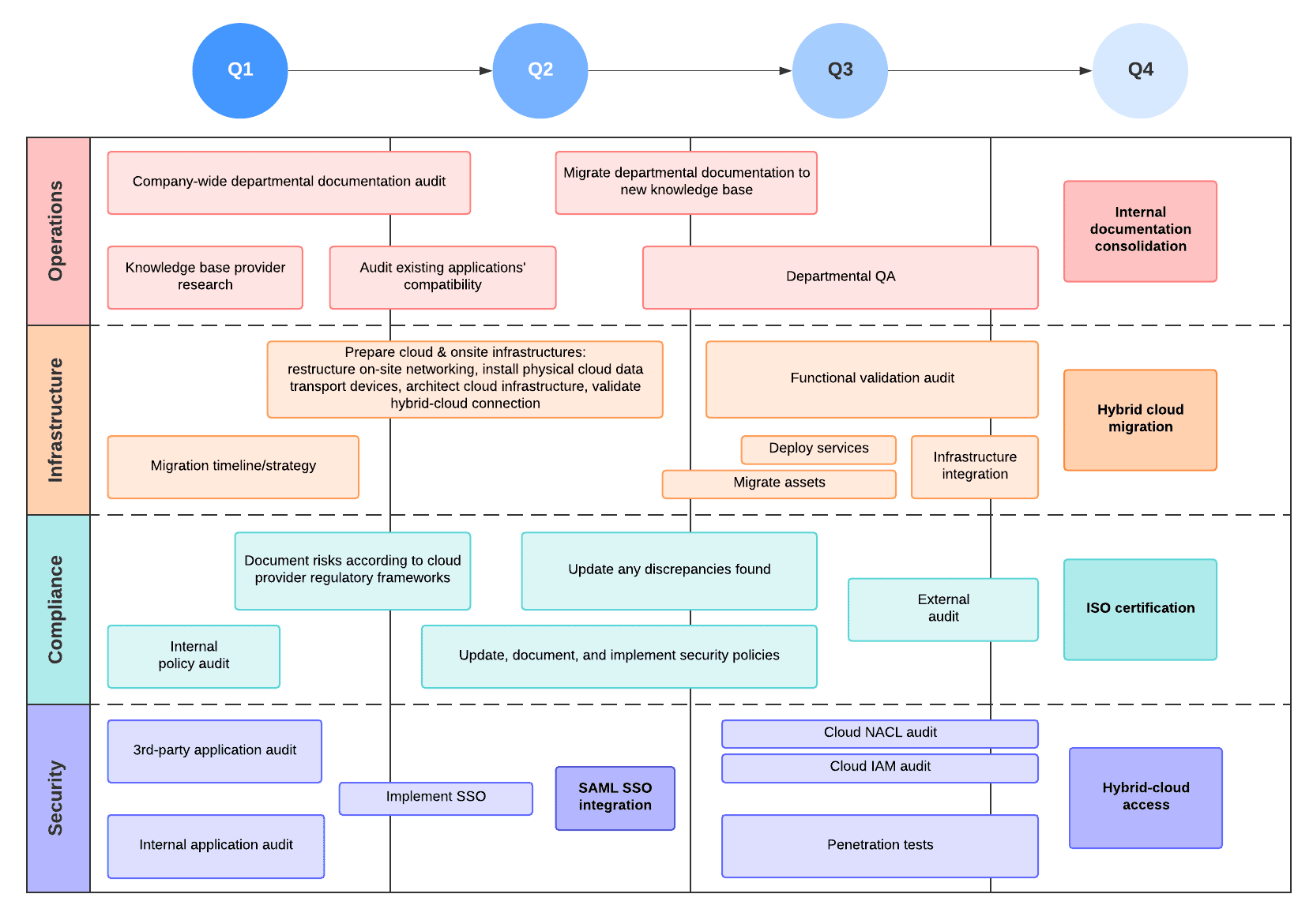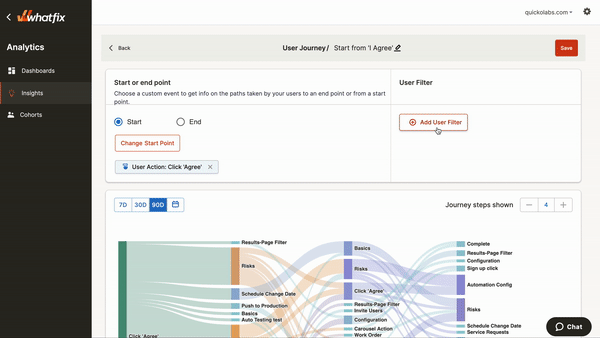
Levi Olmstead


Digital transformation enables organizations to prepare for the future through process automation, the use of big data, and improving customer experiences.
Those enterprises that have successfully executed an organizational transformation quickly see an impact on their company’s bottom line, with an average YOY revenue growth of 17.3% and a net margin of 14% higher than their industry average (MIT).
However, digital transformation is not a simple achievement. Digital transformation requires planning, significant capital investments, long periods of development time, and intensive-heavy people resources.
Because of this, only 22% of CIOs say their company is “digital ready”, according to the previously mentioned MIT study. A Gartner study also recently found that 59% of CEOs said digital transformation initiatives take too long, and 52% said these projects take too long to realize value.
of CIOs said their company is not digitally prepared for transformation projects.
of CEOs said that their digital transformation projects take too long to implement.
In this article, we’ll explore strategies that CIOs, IT leaders, L&D teams, and more can implement to offset the many challenges of digital transformation, foster a culture of innovation, and accelerate digital projects that deliver on the promises of transformation capabilities and initiatives.
As mentioned earlier, organizations that become “future-ready” through successful digital transformation see a 14% higher net margin than similar companies in their industry yet to achieve transformation through digitalization.
On top of the negative impact on revenue growth, slow digital transformation initiatives also:
Here are ten digital transformation acceleration strategies that empower organizations to build, integrate, and launch new digital initiatives that help drive end-user adoption and allow organizations to find value in their technology investments.
While new business technologies may sound exciting, organizations must invest in transformation projects that drive business outcomes aligned with their key drivers and business needs.
First, this means communicating with and educating all leaders – specifically, IT leaders and department heads who are technology decision-makers – on your business’s core needs. This leads to faster development cycles and fewer failed software implementations.
Organizations should also map their future technology investments and business needs the same way product managers roadmap product and feature development, with an IT roadmap. An IT roadmap outlines the overall goals, technologies, tactics, and more in an IT strategic plan that shows how these investments will align with overall business objectives.

54% of organizations say they cannot achieve digital transformation goals because of a lack of digital literacy across their workforce.
This was brought into focus even more in our recent 2024 Digital Adoption Trends Report, where 78% of employees say they lack the expertise of the tools they use on a daily basis and could use additional training and support. Another 84% of employees said there are core features and processes in the software they use every day that they don’t know how to use.
of employees say they lack the digital expertise on the tools they use every day and could use additional training and performance support.
of employees said there are core features and processes in the software they use each day that they don’t know how to use and need additional support on.
While a significant challenge, this can be overcome by continuously upskilling employees to build digital dexterity through various types of employee training – even before you begin your digital transformation efforts.
Many organizations view digital transformation efforts as a way to drive more employee output. Still, it should be viewed as the reverse – digital transformation enables employees to be more productive and perform better by automating routine tasks, leveraging technology to assist them, and being more innovative.
Remember, not all your employees need the same level of upskill training. Your IT and L&D team should work together to identify what cohorts of employees need additional training through a skills gap analysis assessment. This may differ based on employee traits and backgrounds, like age, role, job experience, etc.
Digital transformation efforts typically fall in two categories: operational improvements internally and improving customer experiences. For launching customer-facing transformation projects, there is no better substitute than listening to what your customers have to say about your product or service.
Read customer reviews, gather customer feedback, and set up 1-1 customer meetings with your most valuable partners to understand their expectations of your service. Your customer-facing transformation investments should solve the challenges and problems identified from your customer research.
You should also make it simpler for customers to use your software, which includes providing better customer onboarding experiences and enabling them with self-service support.
A few of the most common customer experience transformation projects to invest in include:



A critical stage of the transformation process is the adoption phase. This is when employees and customers realize the value of new technology or change, and habits form and are built into their workflows. To measure digital adoption, you must track user behavior with event-based product analytics.
With an adoption analytic framework, you can:
With digital transformation adapting to new technologies constantly (ie. see the rapid advancement and integration of AI into everything), IT leaders must embrace the agile methodology as a core company principle. This means building in agile technology frameworks and infrastructure, as 87% of digital leaders say that the ability of their organization to be competitive is highly dependent on their technology architecture’s flexibility.
An agile change strategy also means fostering an agile mindset regarding company culture. Having innovative team members that can quickly adapt to change means your employees will be less likely to resist change, be able to adopt new tools and processes rapidly, have a more open-minded approach to problem-solving, and empower your organization to be more nimble.
Organizations must focus on investing in the right software and technology investments and in digital ecosystems that can be used for many use cases, help solve many use cases and challenges, share data through APIs, and that integrate natively together. This is critical when modernizing legacy applications to prepare for future needs and scaling.
Organizations must also not invest in technology for the sake of investing in technology. According to a recent report from Asana, the average employee uses 13 tools 30 times daily. A report from Vendr found that the average organization wasted $135,000 in 2020 on unused software, or on duplicate software subscriptions. One option to avoid investing in the wrong technology is to hire a digital transformation consulting company.
IT and L&D leaders too often think of training as a one-and-done event. However, employees often encounter issues with digital tasks, especially when completing irregular tasks (ie. performance reviews, data audits, compliance-related tasks, etc).
From our 2024 Digital Adoption Trends Report, 76% of end users said accessing and finding software training and help content is difficult. This compounds with applications releasing product enhancements and new features and companies tweaking or full-on changing internal processes.
This leads to employees becoming frustrated with their digital applications and tasks, leading to poor adoption, lower productivity due to searching for answers independently, and many internal IT support tickets.
To overcome this, organizations should support their team members with employee performance support tools that provide them with contextual self-service help, in the flow of work.
A digital adoption platform (DAP) like Whatfix provides employees with a Self-Help wiki similar to an IT self-service portal that overlays on digital applications and connects with a companies knowledge base, internal wiki, Google Drive, SharePoint, third-party websites, and any form of documentation – allowing employees to find answers at the moment of need.




Whatfix also empowers IT and L&D leaders to add in-app tooltips, beacons, and pop-ups to alert employees of changes to a workflow, new features, or provide them with a guided flow to help finish an irregular task.
One of the drivers of digital transformation is to break down data silos and empower organizations with the analytics they need to make data-driven decisions. Organizations should foster a culture of data literacy through better employee training and more transparent data sharing.
These practices help organizations make better decisions supported by data and uncover previously unseen patterns and trends.
CIOs and IT leaders may know the challenges they face day-to-day, as well as what the business objectives are. Still, they can’t be aware of every department’s core challenges without speaking directly to department leaders and individual employees.
Fostering an open line of communication between IT leaders and employees will allow those in charge of making IT investments contextual understand the most critical challenges and digital friction areas facing their workforce and where they need support.
It also allows IT leaders to openly communicate current IT-related projects and provide warnings and updates on upcoming application and process changes that directly impact individual employees’ routines.
Technology changes rapidly. Those who stay educated on what’s happening in their industry, in the IT world, and on general technology advancements have a leg up on those who follow. Organizations should take advantage of that by providing employees with learning opportunities on emerging trends and technologies, such as lunch and learns, conferences, online subscriptions, and more.
Encourage your employees and leaders to bring new ideas by creating an idea charter system. This will provide a framework for employees to pitch new ideas, help tie them to business objectives, allow organizations to prioritize the interesting ones, and weed out those who aren’t prepared.
A digital adoption platform (DAP), like Whatfix, is a no-code editor that empowers organizations to create in-app overlays, guidance, and self-help support for any end-user – from internal employees to clients, customers, and website visitors.
IT leaders can craft contextual in-app learning experiences, messages, and more, acting as a digital assistant to build digital literacy with end-users, reduce their time-to-value, improve productivity, and empowering outcomes.
Here is a few ways IT, customer success, and L&D teams can accelerate and advance customer-facing and internal digital transformation efforts with a DAP.
With Whatfix, IT and L&D leaders can create in-app guidance and learning content right into the end-users applications. The in-app overlays are made with a no-code visual editor and can be branded to appear native.
A few examples of in-app guidance you can create with Whatfix include:


Whatfix enables non-engineers to create, manage, test, and launch in-app content for use cases such as user onboarding, change management, digital transformation, performance support, end-user support, and more.
Whatfix Self-Help connects with your knowledge base, internal process documentation, internal wiki, LMS, third-party links, and other process and how-to articles to bring all that contextual documentation right into your digital applications and workflows. This support end-users in the flow of work, helping them find the answers to their questions or find additional documentation on how to complete a process.
Whatfix’s Self-Help not only overlays on to any application, it also is searchable and uses AI to help identify and find help documentation for users. Organizations can also create guided flows that can be attached to their Self-Help to provide further context on processes and workflows.




Whatfix Analytics enable organizations to make understand their product usage and engagement, empowering them to make data-driven decisions.
With a no-code implementation, Whatfix’s product analytics is an event-based analytics framework that allows organizations to map user flows, identify drop-offs and friction points, segment users into cohorts, analyze product trends, and drive product adoption. Organizations can then take action based on these analytics, with Whatfix’s analyze, build, deliver framework.


Alert employees or customers to important announcements or guide users to certain areas of your app with Whatfix’s beacons and pop-ups.
Beacons are pulsating dots that overlays on elements in your application. These beacons have messages that appear when a user hovers over them and can be attached to additional walkthroughs for new features or process changes.
Pop-ups are traditional modal windows that allow organizations to embed a video, making a critical announcement, launch a flow for specific cohorts like for a new user product tour, and more.
Whatfix also empowers organizations to gather employee and customer feedback with in-app, native surveys that collect end-user and product feedback in real-time. This feedback includes traditional surveys like NPS and general feedback, as well as post-training feedback that helps gauge how effective and helpful specific user onboarding, training, and support flows and experiences are.


Whatfix empowers enterprise digital transformation efforts by userizing software and technology to meet the needs of end-users. Whatfix supports organizations’ digital adoption strategy with contextual in-app guidance and self-help end-user support.
Analyze product adoption with analytics to make data-driven decisions that leading to technology adoption that helps realize maximize ROI from digital transformation efforts and guides companies to digital transformation success.


Thank you for subscribing!